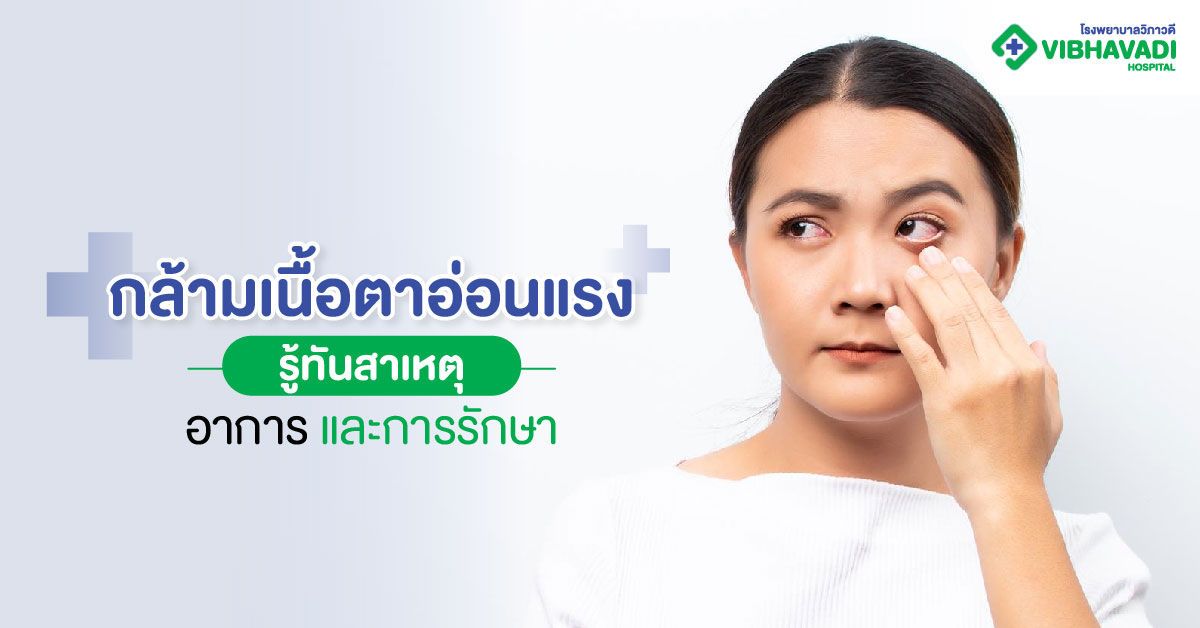Ptosis

Key Takeaway
Ptosis, or eyelid muscle weakness, occurs when the levator muscle cannot lift the eyelid properly. It may result from aging, nerve dysfunction, congenital factors, or chronic diseases. Treatment options include both non-surgical methods such as eye muscle exercises or supportive eyewear and surgical procedures to restore proper eyelid alignment and function.
Understanding Ptosis: Causes, Symptoms, and Treatment Options
Ptosis, medically known as eyelid muscle weakness, is a condition where the upper eyelid droops due to improper functioning of the levator muscle, the muscle responsible for lifting the eyelid. Many people mistake this symptom for simple tiredness or drowsiness, but in fact, ptosis can indicate underlying muscle, nerve, or neurological problems. If left untreated, it may impair vision and affect one’s appearance and confidence.
At Vibhavadi Hospital, ophthalmologists specializing in ocular muscles provide comprehensive diagnosis and both non-surgical and surgical treatments, ensuring patients regain clear vision and confidence.
What is Ptosis?
Ptosis refers to the drooping of the upper eyelid, which can occur in one or both eyes. The condition may be congenital (present from birth) or acquired due to factors such as aging, muscle or nerve injury, tumors, or systemic diseases. The drooping eyelid can partially or completely cover the pupil, making the eyes appear smaller or uneven. Apart from aesthetic concerns, severe ptosis may obstruct vision and interfere with daily activities.
Causes of Ptosis
Ptosis can develop for several reasons, including:
-
Congenital muscle weakness – The levator muscle may not form or function properly at birth.
-
Aging – Natural degeneration of the eyelid muscle or tendon may reduce eyelid lift ability.
-
Nerve disorders – Conditions that damage the nerves controlling eyelid muscles can lead to weakness.
-
Trauma or surgery – Injury or surgical procedures near the eyes may affect muscles or nerves.
-
Tumors or masses – Abnormal growths can compress nerves or muscles around the eye.
-
Chronic diseases – Diabetes and hypertension can cause nerve damage leading to ptosis.
-
Contact lens use – Long-term use of rigid contact lenses may stretch the eyelid tendon.
Symptoms of Ptosis
Ptosis symptoms vary by severity and underlying cause, but commonly include:
-
Drooping or sagging eyelids that make the eyes appear smaller
-
Eye fatigue, especially during prolonged visual tasks
-
Partial blockage of upper vision
-
Multiple eyelid folds from excess skin
-
Lifting eyebrows or forehead to compensate for drooping
-
Uneven or asymmetrical eye appearance
-
Blurred vision or headaches due to eye strain
In Children
Children with congenital ptosis may show:
-
Noticeable asymmetry of the eyes
-
Persistent chin-up posture to see clearly
-
Risk of amblyopia (lazy eye) from blocked vision
In Adults
Adults may experience:
-
Gradual eyelid drooping over time
-
Tired, dull eye appearance
-
Visual difficulties when reading or driving
-
Compensatory forehead wrinkles from lifting brows
In Neurological Disorders
Ptosis from nerve-related diseases such as Myasthenia Gravis or nerve palsy may also cause:
-
Weakness in other facial or body muscles
-
Slurred speech or coordination issues
-
Symptoms worsening with fatigue
Diagnosis of Ptosis
A thorough diagnosis is crucial to identify the cause and severity of ptosis before determining an appropriate treatment plan.
-
Medical History and Observation
The ophthalmologist evaluates the onset, duration, past trauma, underlying diseases, and family history. They also assess eyelid position, eye symmetry, and muscle activity. -
Basic Eye Examination
This includes measuring eyelid height (Marginal Reflex Distance, MRD), visual field testing, and assessing how much the drooping obstructs vision. -
Muscle and Nerve Function Tests
Tests may be conducted to evaluate eye movement, light reflex, and the function of nerves controlling the eyelid. -
Imaging and Laboratory Tests
In some cases, MRI or CT scans may be required to detect tumors or structural abnormalities. Blood tests may help diagnose systemic or neurological causes. -
Differential Diagnosis
Ptosis must be distinguished from other causes of drooping eyelids such as nerve palsy, inflammation, or trauma to ensure precise treatment.
Treatment Options for Ptosis
Treatment depends on the cause and severity. At Vibhavadi Hospital, ophthalmologists customize the treatment to restore eyelid function and appearance effectively.
1. Non-surgical Treatments
For mild cases or as interim solutions before surgery, non-invasive options include:
-
Ptosis crutch glasses: Special eyeglasses that help lift the eyelid.
-
Eye muscle therapy: Exercises that strengthen eyelid control.
-
Eye drops: Medications that temporarily stimulate muscle function.
-
Lifestyle adjustments: Reducing eye strain and ensuring adequate rest.
2. Surgical Treatments
Surgery is often required for moderate to severe ptosis. Procedures include:
-
Levator resection or advancement: Tightening or shortening the eyelid muscle to restore lift.
-
Frontalis sling surgery: Connecting the eyelid to the forehead muscle for cases with very weak levator function.
-
Cosmetic enhancement: Surgery may be combined with double-eyelid creation for a natural, balanced appearance.
Post-surgery, swelling or bruising may occur temporarily, but results are typically long-lasting with proper care.
3. Post-Treatment Care
After treatment, patients should:
-
Apply cold compresses to reduce swelling
-
Avoid rubbing or pressing the eyelids
-
Follow prescribed medication and eye care routines
-
Attend regular follow-ups to monitor healing and prevent complications
Can Ptosis Heal on Its Own?
In most cases, ptosis does not resolve spontaneously. It rarely improves without medical treatment, as the underlying muscle or nerve damage does not recover naturally. Only temporary drooping caused by fatigue or dry eyes may improve with rest—but this is not true ptosis. Early medical consultation ensures timely intervention and prevents permanent vision impairment.
Possible Complications if Left Untreated
If untreated, ptosis can lead to several complications, including:
-
Amblyopia (lazy eye): Particularly in children, drooping eyelids can block visual development.
-
Visual obstruction: Reduced field of vision affects reading, driving, and daily activities.
-
Facial muscle strain: Constant eyebrow lifting may cause forehead wrinkles or chronic headaches.
-
Psychological effects: Altered eye appearance can affect self-confidence and social interactions.
-
Underlying neurological disease progression: In cases linked to systemic diseases, delayed treatment may worsen other body functions.
Prevention and Eye Care Tips
While not all cases are preventable, the following habits can help reduce the risk or detect ptosis early:
-
Take regular eye breaks and avoid excessive screen time
-
Protect eyes from trauma or foreign objects
-
Manage chronic diseases like diabetes and hypertension
-
Maintain a healthy diet rich in vitamins A and E
-
Get routine eye checkups, especially for children and older adults
-
Seek prompt medical attention for early signs of drooping eyelids
Ptosis Treatment at Vibhavadi Hospital
At Vibhavadi Hospital’s Eye Center, patients receive specialized care from ophthalmologists experienced in eye muscle disorders. Using advanced diagnostic tools and individualized treatment plans, the hospital offers both non-surgical therapy (muscle training, corrective glasses) and surgical solutions to restore normal eyelid position.
Patients benefit from precise surgical techniques, modern technology, and post-treatment rehabilitation programs designed to improve both visual function and appearance. The hospital prioritizes safety, comfort, and optimal outcomes.
For appointments or more information, contact Vibhavadi Hospital Eye Center at Tel. 02-561-1111.
Summary
Ptosis, or eyelid muscle weakness, occurs when the levator muscle cannot properly lift the upper eyelid, leading to drooping, impaired vision, and aesthetic concerns. Causes include congenital defects, aging, trauma, neurological disorders, or chronic diseases. Diagnosis involves clinical examination, nerve testing, and imaging. Treatments range from non-surgical options like ptosis crutch glasses to surgical correction. Without proper care, ptosis may cause vision loss or affect facial balance and confidence.
At Vibhavadi Hospital, patients can expect accurate diagnosis, modern treatment, and specialized post-care for safe and effective recovery.
Frequently Asked Questions (FAQ)
1. How is ptosis different from general eyelid drooping?
Ptosis stems from muscle or nerve weakness affecting eyelid lift, while general drooping often results from skin laxity or aging without muscle involvement.
2. Should children with ptosis receive immediate treatment?
Yes. Early diagnosis is crucial to prevent amblyopia (lazy eye) and ensure proper visual development.
3. Is ptosis surgery safe?
When performed by experienced ophthalmic surgeons, ptosis surgery is safe. Minor side effects such as swelling or dryness are temporary.
4. Can ptosis be related to other eye diseases?
Yes. It may occur with neurological or systemic disorders such as Myasthenia Gravis or diabetes-related nerve damage.
Testimonials
Proud to take care of you


























